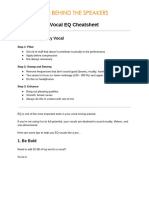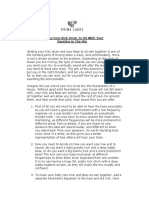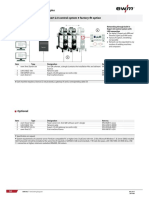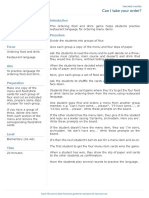Mixing Cheat Sheet
Mixing Cheat Sheet
Uploaded by
mcCopyright:
Available Formats
Mixing Cheat Sheet
Mixing Cheat Sheet
Uploaded by
mcOriginal Description:
Original Title
Copyright
Available Formats
Share this document
Did you find this document useful?
Is this content inappropriate?
Copyright:
Available Formats
Mixing Cheat Sheet
Mixing Cheat Sheet
Uploaded by
mcCopyright:
Available Formats
✅
Mixing Cheat Sheet
DIY Music Guide
www.diy-music-guide.com
File Import and Prep
Check for unified sample rate and bit depth across all audio assets.
Import files into your DAW using drag and drop or the import command.
Once imported, use the consolidate project command to copy all of your audio
assets into the same master project folder.
Check macro time alignment: is everything where it’s supposed to be and playing
correctly in time?
Check macro volume adjustment: select all tracks, then pull down the volume on
everything until your master track is hitting between -12 and -6 dB in the loudest
part of the song. Do not do this by adjusting only the master track, it must be done
to each track individually.
Turn up the volume on your speakers or headphones to return to a comfortable
mixing volume on your monitors.
Cleanup and Grouping
Check micro time alignment (phase). First, place a phase correlation meter on the
master track. You should see this meter weighted heavily towards the +1 side (or,
“in-phase”). Dipping a little bit towards 0 is OK here and there, but the meter
shouldn’t be touching 0 or moving into -1 territory. If you see this, you have out-of-
phase components in your mix that you will need to address before continuing.
To address any out-of-phase components, you need to first find the offending
tracks or microphones, and then use a micro-delay (such as a sample delay) to
bring them back into phase. You could also manually drag the audio on the
Mixing Cheat Sheet 1
timeline while zoomed in, or use something like an autophase plugin. Be sure
that you’re phase adjusting all items to a single reference track to keep
everything in rhythm. In a rock song, the kick drum is typically used as the
reference track for phase adjustment.
Phase alignment is an advanced technique used in professional production,
and maybe not necessary for a simple demo, or material not intended for
release.
Trim silences as necessary; i.e. when an instrument is not making sound, cut out
the silent area.
Add micro fades to the beginning and end of all audio regions as necessary, to
prevent clicks and pops.
Group audio tracks by instrument first, then by musical idea (i.e. lead guitar, rhythm
guitar, drums, vocals, background vocals, etc).
Color code each audio group in a visually logical manner (i.e. all guitars are green,
all vocals are purple, all background vocals are red-purple, etc).
At this point, you should have a DAW project that contains time aligned, cleaned,
and in-phase audio with minimal noise (or however much noise you want to leave
in), and no clipping on the master track. Your project should look visually
organized: grouped and color coded by instrument. We are now ready to mix.
Equalization
EQ the most foundational musical or rhythmic sounds first. In a rock song, this is
usually the drum kit and bass guitar; in an acoustic track, it could be the rhythm
guitar. In a choir piece, it could be the bass vocals, or whichever vocal line that
contains the rhythmic information.
After the foundational sounds are working nicely together and sound clear, move
progressively up the mix, adding additional instrument groups and EQing one at a
time. You often want to EQ the vocals last.
EQ by group first, drilling down into individual mics only as necessary.
Mixing Cheat Sheet 2
Use subtractive (cutting) EQ often, and additive (boosting) EQ carefully. Your
general aim is to remove unnecessary and/or conflicting frequencies, while
maintaining the musical characteristics of the track as a whole. Hint: most
instruments that aren’t the kick drum and bass guitar do not need a lot of low
frequency information left in.
Don’t be afraid to use the solo button and work on an individual sound, but always
check your EQ choices against the context of multiple instruments playing together,
instruments groups, and the track as a whole. An EQed track might sound odd
when solo’d but perfect when played together with everything else, and that’s OK.
Panning
If you’re EQing correctly, you should be able to get to a reasonably clear sounding
mix with everything firing straight up the center.
Once you’ve achieved this, you can now start to move instruments around the
stereo field. Be judicious, and try to get to an expansive sounding mix keeping your
panning choices between 9 and 3 on the dial.
Common panning choices:
drum overheads panned as if listening from the audience perspective.
kick drum, bass guitar, and other bass instruments firing straight up the center.
complementary guitar lines panned wider left and right.
lead vocals straight up the center.
Save your hard pans (more than 9-3 on the dial) for special effects that contain
mid/high frequency sounds. Don’t hard pan everything.
Beware hard panning of the bass, and other low end instruments.
Compression
Begin compressing with the musically foundational instruments, just as with EQ.
Try compressing at the group level first, digging into individual tracks only as
necessary.
Once your foundational instruments are set, move up the mix, adding instrument
groups one at a time. You will often end with the vocals.
Mixing Cheat Sheet 3
Choose your compression circuitry based on musical intent:
FET compressors are often used in rock styles for added thickness and punch.
Optical compressors are often used in acoustic tracks, or for a more transparent
and natural sound.
VCA compressors are often used in rock and rap styles, and can be pushed
hard for obvious effect, or to intentionally trash sounds.
It’s OK to jump back and forth between the EQing and Compression steps several
times, before moving on to adding effects. Compression and EQ are interrelated,
and a change made to one often effects the other.
At this point, you should have a track that sounds clear and punchy, with all
sounds being easily heard, and the vocals (if present) sitting nicely on top of the
mix. We are now ready to add additional creative interest with effects.
Effects
Place reverb and delay effects on a bus, and send different audio to that bus, rather
than placing individual effects on every track. This lets you blend in just the right
amount of your effect, while saving processor power and achieving a more cohesive
sound across the mix.
Always EQ your reverbs! You don’t need a lot of low end reverb mud flopping
around your mix. Reverbs work quite well keeping the middle and high frequencies
in, and strongly reducing the lows.
Make sure your reverb choices aren’t throwing your mix out-of-phase. Keep
checking that phase correlation meter on your master track regularly as you mix.
Finishing Touches
Check your master track volume, and make sure you’re still hitting between -6 and
-12 dB, especially if you’re using a mastering engineer or mastering yourself (you
should be doing one of those two things!)
If it’s a rough mix that isn’t for release, you can get away with a higher final output
level, but always watch out for clipping on your master track. Use a limiter (only if
Mixing Cheat Sheet 4
necessary) on your master track to control clipping, but only in a rough mix
situation. For release material and/or mastering handoff, do not limit your master
track. Your mastering engineer will handle this for you, if they’re any good.
Experiment with adding master track compression and EQ as you like, but keep in
mind that small changes lead to big results here, and it is very easy to overdo it and
mess up the mix you just spent so much time working on. If you’re sending this mix
out to be mastered, many mastering engineers strongly prefer that you leave the
master track empty.
Keep in mind that some labels won’t accept unmastered submissions, because an
unmastered track is not a true reflection of the quality of your finished work.
Mastering should always be a part of the production process, whether you hire it out
or do it yourself. This checklist is aimed at providing you with a high quality rough
mix that is properly prepared for handoff to mastering, as the next step in the
production process.
At this point, you should have a track that sounds clear and punchy, with
interesting effects and creative choices, and with no clipping on the master track.
We’ve achieved a great rough mix: congrats! Now, we’re ready for the final
exporting step: bouncing our multitrack audio project down to a 2-channel stereo
file that can be sent out to mastering, or played back on any standard audio
player.
Export
Hit select-all or drag select to set the bounce point start and end to include all audio
regions of your track.
Add an additional amount of silence at both the start and end of the bounce. It’s
best practice to leave at least a second or two of silence in your mix at the
beginning and end of the track, so you can tweak the fade in/fade out during
mastering.
Bounce your mix at the same sample rate and bit depth as your tracks were
recorded at. If you recorded at 16 bit/44.1 kHz (perfectly fine for demos and rough
stuff), make sure you bounce your mix at that same resolution. Same goes if you’re
Mixing Cheat Sheet 5
using higher bit depth and sample rates. Do not do any sample rate or bit depth
conversions at this point; we’ll handle that in mastering as necessary.
Once your mix is bounced down to a stereo file, play back that stereo file to be sure
nothing weird happened with the bounce. If everything sounds good throughout the
track, you’re all done!
Congratulations on finishing your first rough mix! There’s a lot of steps here, but
don’t worry, you don’t have to remember them all right now. Keep this list handy,
practice the steps in the same order every time, and you’ll be amazed at how
quick you can get at this after some repetition. Good luck, and happy mixing!
Mixing Cheat Sheet 6
You might also like
- Acoustic Guitar Frequency Range: The Acoustic Guitar Is Very Similar To The Human Voice in That It Has A VeryDocument54 pagesAcoustic Guitar Frequency Range: The Acoustic Guitar Is Very Similar To The Human Voice in That It Has A Veryabyalex100% (2)
- Mike Deans Mix Tips PDFDocument4 pagesMike Deans Mix Tips PDFkgabomolomo06No ratings yet
- 56 Mix Tips for the Small Recording Studio: For the Small Recording Studio Series, #2From Everand56 Mix Tips for the Small Recording Studio: For the Small Recording Studio Series, #2Rating: 5 out of 5 stars5/5 (3)
- Kaelin Ellis Free Guide For Drum MixingDocument10 pagesKaelin Ellis Free Guide For Drum MixingMatias Nahuel GuardianiNo ratings yet
- Aptitude TestDocument3 pagesAptitude TestEmmanuel100% (1)
- Mastering: GuideDocument61 pagesMastering: GuideJohanan Torre PinaresNo ratings yet
- Mixing Instruments & Mixing Synths - A Step-By-Step GuideDocument1 pageMixing Instruments & Mixing Synths - A Step-By-Step GuideIrisNo ratings yet
- Synthesizer Cookbook: How to Use Filters: Sound Design for Beginners, #2From EverandSynthesizer Cookbook: How to Use Filters: Sound Design for Beginners, #2Rating: 3 out of 5 stars3/5 (4)
- 44 Reasons Your Mixes Suck - A Mixing Engineer's GuideFrom Everand44 Reasons Your Mixes Suck - A Mixing Engineer's GuideRating: 4.5 out of 5 stars4.5/5 (6)
- How To Mix Music (Part 1) FundamentalsDocument11 pagesHow To Mix Music (Part 1) FundamentalsLeanghai LHNo ratings yet
- Vocal Mixing Cheatsheet PDFDocument6 pagesVocal Mixing Cheatsheet PDFALEX0% (1)
- Vocal Mixing CheatsheetDocument5 pagesVocal Mixing CheatsheetMiss JujukNo ratings yet
- 3 Hit Song ArrangementsDocument1 page3 Hit Song ArrangementsLukeNo ratings yet
- How To Mix Part 2Document9 pagesHow To Mix Part 2NickNo ratings yet
- Mixing Drums & Mixing Bass - How To Mix Music (Part 4)Document24 pagesMixing Drums & Mixing Bass - How To Mix Music (Part 4)SteveJonesNo ratings yet
- Audio Compression 101Document9 pagesAudio Compression 101BalasubramaniNo ratings yet
- The Mixcoach Guide To Setting LevelsDocument4 pagesThe Mixcoach Guide To Setting LevelstristdebuffNo ratings yet
- More Mixing Techniques 2Document3 pagesMore Mixing Techniques 2IKKVM MVKKINo ratings yet
- Low End Mixing CheatsheetDocument6 pagesLow End Mixing CheatsheetAndreDaher100% (2)
- How To Mix Music (Part 1) : Fundamentals: MonitoringDocument86 pagesHow To Mix Music (Part 1) : Fundamentals: MonitoringSilfredim MercuryNo ratings yet
- 101mixing&productiontips PDFDocument21 pages101mixing&productiontips PDFGabriel Maynart100% (2)
- The Essential Checklist: Preparing For MasteringDocument10 pagesThe Essential Checklist: Preparing For MasteringAlberto ChagasNo ratings yet
- How-To Make Trance Kick Drums by QuasarDocument4 pagesHow-To Make Trance Kick Drums by QuasarBogdan LinaNo ratings yet
- Mixing GuideDocument66 pagesMixing GuideSamuel AndradeNo ratings yet
- Creating The Perfect MixDocument15 pagesCreating The Perfect MixLeibenys de SouzaNo ratings yet
- How To Remix Music Genres: A Remix Philosophy and Remix Music Genre GuideFrom EverandHow To Remix Music Genres: A Remix Philosophy and Remix Music Genre GuideRating: 3 out of 5 stars3/5 (2)
- Music Production for Beginners: How to Make Professional Electronic Dance Music, The Ultimate 3 in 1 Bundle for Producers (Synthesizer Explained, The Ultimate Melody Guide & Mixing EDM Music)From EverandMusic Production for Beginners: How to Make Professional Electronic Dance Music, The Ultimate 3 in 1 Bundle for Producers (Synthesizer Explained, The Ultimate Melody Guide & Mixing EDM Music)No ratings yet
- 36 Song Arrangement Tips for the Small Recording Studio: For the Small Recording Studio Series, #4From Everand36 Song Arrangement Tips for the Small Recording Studio: For the Small Recording Studio Series, #4Rating: 5 out of 5 stars5/5 (7)
- Synthesizer Explained: The Essential Basics of Synthesis You Must Know as a Digital Music Producer (Electronic Music and Sound Design for Beginners: Oscillators, Filters, Envelopes & LFOs)From EverandSynthesizer Explained: The Essential Basics of Synthesis You Must Know as a Digital Music Producer (Electronic Music and Sound Design for Beginners: Oscillators, Filters, Envelopes & LFOs)Rating: 2 out of 5 stars2/5 (3)
- Clear Mix Cheatsheet 2Document7 pagesClear Mix Cheatsheet 2Makki ABDELLATIFNo ratings yet
- Mix Prep Cheat SheetDocument1 pageMix Prep Cheat SheetJaime Saldanha100% (1)
- 10 Mixing Tips by Doctor Mix PDFDocument3 pages10 Mixing Tips by Doctor Mix PDFAntonio TriángelNo ratings yet
- Vocal Eq CheatsheetDocument5 pagesVocal Eq Cheatsheetnoor shaheenNo ratings yet
- Academy - FM Ultimate Guide To Mixing Dance Music GROUPEDDocument6 pagesAcademy - FM Ultimate Guide To Mixing Dance Music GROUPEDJam ChoiNo ratings yet
- 5 Things You Should Never Do While MixingDocument3 pages5 Things You Should Never Do While MixingLui KennethNo ratings yet
- How To Finish A Mix Checklist - With David GlennDocument1 pageHow To Finish A Mix Checklist - With David GlennmgiullittiNo ratings yet
- How To Mix Music (Part 2) Signal Flow & PluginsDocument18 pagesHow To Mix Music (Part 2) Signal Flow & PluginsLeanghai LHNo ratings yet
- Mixing DrumDocument10 pagesMixing DrumSalawe KomputerNo ratings yet
- How To Mix Music (Part 3) : Stereo Image & Mixing Tips: Heroic - AcademyDocument8 pagesHow To Mix Music (Part 3) : Stereo Image & Mixing Tips: Heroic - AcademyNickNo ratings yet
- Getting Your Kick Drum To Sit With Your BasslineDocument5 pagesGetting Your Kick Drum To Sit With Your BasslineJorge Emilio Martínez TrejoNo ratings yet
- How To Mix Part 5Document15 pagesHow To Mix Part 5NickNo ratings yet
- A Rule of Thumb Guide To Professional EQ EbookDocument13 pagesA Rule of Thumb Guide To Professional EQ EbookAmine Ben Ayed100% (1)
- Vocal Processing ChainDocument1 pageVocal Processing ChainBrod LenamingNo ratings yet
- 6 Manoeuvres For Mixing With EQDocument18 pages6 Manoeuvres For Mixing With EQFaustoNo ratings yet
- 14 - Master Your Mix in 14 StepsDocument1 page14 - Master Your Mix in 14 StepsbopdubNo ratings yet
- Multi Band Cheat SheetDocument2 pagesMulti Band Cheat SheetPedro AlvaradoNo ratings yet
- Mastering PDFDocument8 pagesMastering PDFIan DavisNo ratings yet
- Guide To Dynamics Control!: v1.04! February 20th, 2012!Document13 pagesGuide To Dynamics Control!: v1.04! February 20th, 2012!pestao123No ratings yet
- How To Mix Kick Bass Mastering The Mix PDFDocument14 pagesHow To Mix Kick Bass Mastering The Mix PDFKahlil SmithNo ratings yet
- Vocal ReverbDocument6 pagesVocal ReverbjijothibokNo ratings yet
- Live Sound Tips For BeginnersDocument7 pagesLive Sound Tips For BeginnersMinh NguyenNo ratings yet
- The Ultimate Guide To Mixing VocalsDocument11 pagesThe Ultimate Guide To Mixing VocalsMinh NguyenNo ratings yet
- 15 Reverb Tips From PDFDocument2 pages15 Reverb Tips From PDFnetzah2padreNo ratings yet
- 2 - How To Gain Stage Your MixDocument1 page2 - How To Gain Stage Your MixheraNo ratings yet
- Drum Mixing CheatsheetDocument4 pagesDrum Mixing CheatsheetMarcos Avila100% (1)
- Eq MixDocument9 pagesEq MixAizat IkhwanNo ratings yet
- Failure Criteria in Fibre Reinforced Polymer Composites PDFDocument2 pagesFailure Criteria in Fibre Reinforced Polymer Composites PDFMichaelNo ratings yet
- CrochetDocument2 pagesCrochetAlicia Perlo100% (3)
- KNITWITS™ School Fundraiser OverviewDocument5 pagesKNITWITS™ School Fundraiser Overviewagiles_8No ratings yet
- Sound Waves and MusicDocument8 pagesSound Waves and MusicJose RattiaNo ratings yet
- Silent Scream - Anna BlueDocument1 pageSilent Scream - Anna BlueSamuel MorenoNo ratings yet
- Bella CiaoDocument5 pagesBella CiaoAdelina MNo ratings yet
- Human Open Hand MonkDocument1 pageHuman Open Hand Monkcamilo duqueNo ratings yet
- A Summer Day Out-Reading and Vocabulary ExercisesDocument2 pagesA Summer Day Out-Reading and Vocabulary ExercisesAnonymous bCDc6BvNo ratings yet
- Hi There!!: This Is A Defined Block Style Called BlockstyletestDocument2 pagesHi There!!: This Is A Defined Block Style Called BlockstyletestTimothy WestNo ratings yet
- Sudano v. WestDocument16 pagesSudano v. WestBillboardNo ratings yet
- Infinitivo Significad o Conjugação InfinitivoDocument4 pagesInfinitivo Significad o Conjugação InfinitivoBruno AlvesNo ratings yet
- Best Chill Out and Melodic DSG ListDocument2 pagesBest Chill Out and Melodic DSG ListAlex BazilNo ratings yet
- XnetDocument3 pagesXnetjarvishNo ratings yet
- Drogi Dojazdowe TLDocument2 pagesDrogi Dojazdowe TLJustyna JędruchNo ratings yet
- 2022 2023 فينيسياDocument74 pages2022 2023 فينيسياAhmed alajilyNo ratings yet
- DreamsDocument5 pagesDreamsapi-302152835No ratings yet
- 5-Computer BasicDocument43 pages5-Computer BasicJenna Marie TolosaNo ratings yet
- Besitos TabDocument6 pagesBesitos TabRaul Daniel Trejo GuzmanNo ratings yet
- Can I Take Your Order?: Activity TypeDocument2 pagesCan I Take Your Order?: Activity TypeLight EnglishNo ratings yet
- Ruskin Bond BiographyDocument1 pageRuskin Bond BiographyRohit Micka50% (4)
- Haldiram and BikanerDocument14 pagesHaldiram and BikanerVivek NahtaNo ratings yet
- E-Ticket 3008814124404: Download Yatra AppDocument2 pagesE-Ticket 3008814124404: Download Yatra AppParas KambojNo ratings yet
- Citra Log - Txt.oldDocument6 pagesCitra Log - Txt.old恋人PpxcsNo ratings yet
- Harvey Washbangers MenuDocument4 pagesHarvey Washbangers MenuwashbangersNo ratings yet
- Unit 11 New WorldDocument4 pagesUnit 11 New WorldThu TrangNo ratings yet
- RivetingDocument7 pagesRivetingapi-132751606No ratings yet
- Past Vegas: by Ameni RozsaDocument21 pagesPast Vegas: by Ameni RozsaamenirozsaNo ratings yet
- Versuri AdeleDocument3 pagesVersuri AdeleMariana DoldierNo ratings yet
- Daily Production Report Cutting Order Qty. (Extra % Included)Document9 pagesDaily Production Report Cutting Order Qty. (Extra % Included)imtiazNo ratings yet

























































































